Kuhlman Cellars Blog
Texas Terroir, a brief synopsis
There are so many factors involved in producing a quality bottle of wine, as things all begin in the vineyard and make their way to the cellar. Most of us can certainly agree, weather and soil play a very important role in winemaking. What better place to discuss soil types than in the Lone Star State. Texas itself sits on a rock shelf and depending on where you live in our wonderfully enormous state, you either have a little or a whole lot of rocks in your backyard. There is a reason most central Texans construct raised gardens, it is because you can literally bend a pick axe trying to dig into the limestone and caliche. Who wants to rent a Bobcat just to plant tomatoes?
Let’s talk a little about the two largest AVA’s in Texas, and how different the soils can really be. Understand this story is not a definitive- end all lecture about the structure of Texas dirt, merely a brief explanation of some of the key differences between the soil of Central Texas, vs that of the Texas High Plains. With such a large wine style dynamic between fruit from the Hill Country vs the High Plains, there has to be something unique regarding each region right? The answer is yes, both in climate and dirt, this thing we call terroir. What is terroir exactly? Simply put, it is the all-encompassing word for wind, rain, temperature, soil, elevation, etc, of a given region. Here are some interesting facts on the two prominent regions we are discussing.
Texas Hill Country AVA:
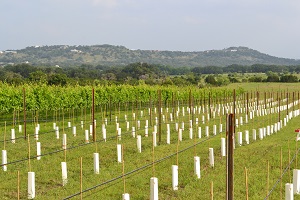
Impressively the second largest AVA in the United States, it covers 9,000,000 acres (14,063 square miles) and contains 2 sub regions; Bell Mountain AVA and Fredericksburg AVA. Elevation can range from roughly 1,000 ft MSL to over 2,500 ft MSL. The weather in central Texas is typically hot during the growing season. Hill Country daily high temperatures average in the in the mid 90’s, while the nights drop into the low 70’s. The soils vary in this region, but limestone and caliche reign. For example, the Kuhlman Cellars Estate Vineyard sits on a bedrock of Caliche with a clay topsoil. There are spots in the vineyard where the clay is only a few inches deep, you can ask our vineyard team. I cannot tell you how many vines we placed directly on white chalky rock when we planted the estate vineyard in April, 2015. It is basically “set the roots on rock, replace the soil, and wish it good luck”. Struggle little fella, struggle! The rocky terroir of central Texas is typically well draining, though the clay can cause all sorts of issues since it retains moisture. The caliche provides good mineral component to the wines made from these vineyards.
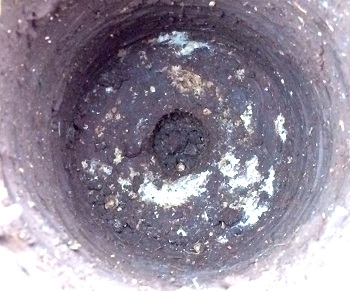
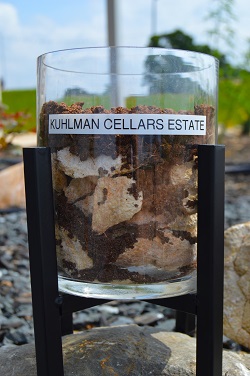
Texas High Plains AVA:
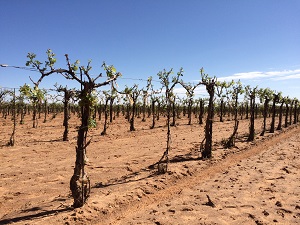
This is the second largest AVA in Texas and it also contains the most vines. It’s estimated, west Texas grows 90% of the fruit grown in the state, especially in the Brownfield/ Lubbock area. The Texas High Plains is far different from the Hill Country in a few ways, the elevation is significantly higher allowing for more of that much needed diurnal shift. Elevation in this region ranges from around 2,500 ft MSL to over 3,700 ft MSL. The soil is mainly composed of red dirt/sand with loam as well. There is quite a bit of rock in Lubbock, but it is typically buried under several feet of the famous red dirt. Sand is very well draining soil. Humidity levels here are typically very low, making the region ideal for grape growing, by reducing the incidence of fungus and molds.
In terms of temperature, the high plains tends to be slightly cooler during the days and the nights cool off into the mid to upper 60’s, providing a larger diurnal shift which helps the grapes rest and recover overnight.
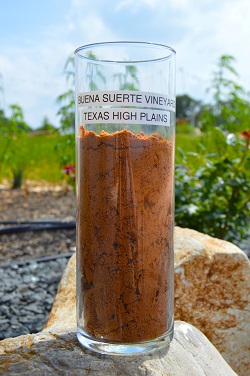
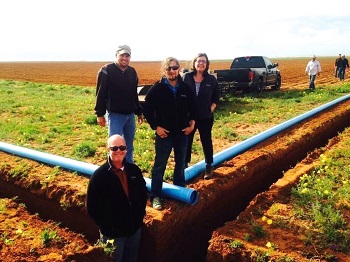
All in all Texas is a diverse place to grow grapes and to make fine wines. I hope this brief synopsis helps you to understand a bit more about our local industry and what makes our two biggest AVA’s so unique, fun and interesting.
Field trip to Kuhlman Creek!
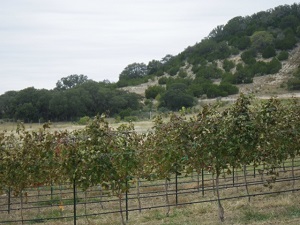
On a bitter cold winter day, some of the Kuhlman Cellars team, including myself, were walking the vines at the Cobb Family Vineyard.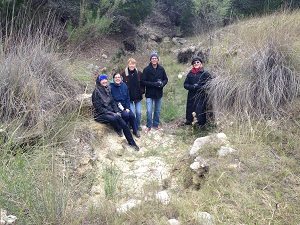 It was a company field trip of sorts and I was excited to finally step foot on the soils of the family "farm". This is where the winery name was born, for Kuhlman Creek which runs through the property and feeds into the Pedernales River when heavy rains fall. During our trip the sky was grey, and the vines had just begun their long winters slumber. Green leaves with hints of red and gold were clinging from the hard worked vines.
It was a company field trip of sorts and I was excited to finally step foot on the soils of the family "farm". This is where the winery name was born, for Kuhlman Creek which runs through the property and feeds into the Pedernales River when heavy rains fall. During our trip the sky was grey, and the vines had just begun their long winters slumber. Green leaves with hints of red and gold were clinging from the hard worked vines.
The 1 acre test block has been a solid experiment over the last few years of how several grape varieties grow on the family property, just north of Fredericksburg, Texas. The vineyard presently contains 9 different grape varieties. This specific piece of land is blessed with terroir conducive to protecting the vines from hail and late spring freezes. Hills to the north have proven to disrupt the worst of severe Thunderstorms, and downward sloping terrain to the south allows cold air during the late spring to flow through and away from the vineyard. This is especially important in protecting our lovely Viognier from having her gentle buds frozen in late March and early April. The intimate tour of the property that day was given by Diane Cobb, our vineyard matron. I hesitate to call her a vineyard manager, because the love she shows each and every vine, is much more motherly than managerial.
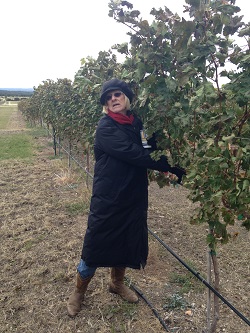
The Vitis Vinifera grape varieties currently planted at the Cobb Family Vineyard:
Aglianico
Alicante Bouschet
Carignan
Mourvèdre
Syrah
Tannat
Tempranillo
Vermentino
Viognier
There is a special estate field blend from the first harvest currently in barrels here at the winery structured solely from the fruit sourced from the Cobb Family Vineyard. This limited release wine will be something to look forward to in a few years once released. This wine will express the unique nuances of the terroir, which is instrumental when it comes to the complexity and individuality of wine.
We invite all of you to come experience the splendors of terroir with each of our carefully made wines at Kuhlman Cellars. Each one tells its own story of the dirt, rainfall, sunlight and wind of that particular growing season.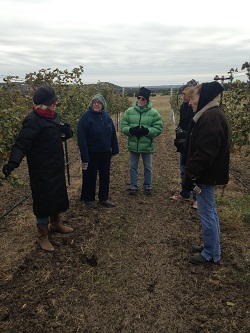
Cheers!
Estate Vineyard Construction!
We've begun the earth works for the new estate vineyard!
There are several steps taken to put the vineyard in, including several which happen before we ever plant a vine.
Before we begin, we layout the vineyard blocks and agree on the orientation of the rows and the placement of the irrigation pipes. Generally, we want the rows to run north / south so as to get the best sunlight as the sun moves from east to west. Irrigation lines need to account for elevation shanges to ensure each vine gets the same amount of water - we don't want only the vines at the bottom of the rise to get water!
We start the land preparation by eliminating whatever is currently growing on the site. For the last ~20 years, the estate pasture was cultivated for coastal hay production. Coastal is a durable and resiliant grass and it handles period of drought by going dormant and then waking up once rains come. This means the roots are strong and well developed.
Once the coastal is eliminated, we rip the soil to fragment it and provide air for the to-be-planted vines. This involves running a large dozer over the ground and pushing long ripping blades into the earth to "rip up" the soil. We captured a short segment of this ripping in action in the video below!
The next steps include installing the trellising, running the irrigation lines and planting cover crops. All of this has to take place prior to the vines planting in the late spring.
Stay tuned and come visit to watch as we progress through the establishment phase in preparation for planting the first vineyard blocks next spring.
First Estate Harvest!
We've anticipated this day for several years - ever since we bought the familty farm back in 2010 - we've thought about having our first harvest from the test vineyard!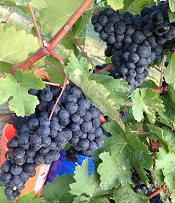
Well, today we gathered with some family and friends and harvested the first few varietals. This includes the Tempranillo, Viognier and some of the Alicante Bouschet. As we will do moving forward, this was a hand harvest where we take each cluster from the vines using hand shears. This provides a gentle handling of the fruit and also allows us to select only the best clusters and leave any damaged or otherwise less than pristine fruit.
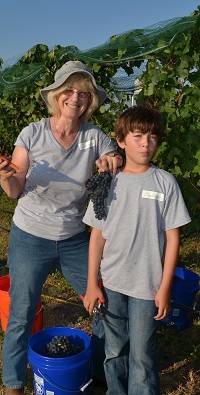 There was a big celebration from everyone as we met at the south end of the viognier row and had Reed and Diane, our vineyard manager and winegrower respectfully, take the first two clusters. Some of the clusters were Huge! Especially both the Tempranillo and the Alicante.
There was a big celebration from everyone as we met at the south end of the viognier row and had Reed and Diane, our vineyard manager and winegrower respectfully, take the first two clusters. Some of the clusters were Huge! Especially both the Tempranillo and the Alicante.
We were very pleased with the amount of fruit harvested! In fact the clusters were larger than we anticipated, so our total weight was a fair bit more than predicted. The quality also could not be better!
Once harvested we then took the fruit to be destemmed and then sorted to ensure only the best berries and no MOG (material other than grapes) made it into the fermenter. This is an intensively manual process as the team literally looks at every single grape to identify those flawed items and / or potentially foriegn objects and hand removes them. It is a lot of fun, and there is always good conversation to be had as your eyes and hands do the work, but leave your mind and mouth for friendly conversation.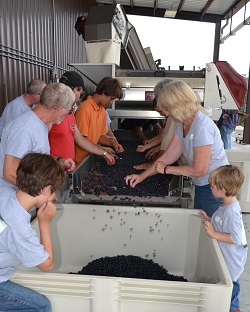
The fruit is all co-fermented. This simply means we are not separating the different grape types, but are putting them all in the same vessel for fermentation. This is a classic old-world approach to winemaking and it suits our needs very well with the existing vineyard.
What will the sine be like when done? Stay tuned and be patient as it will be a few years before we know the real result of our labors!
Robert Clay Vineyards
We spent the day with Dan McLaughlin in Robert Clay Vineyards recently where we helped with netting the Merlot as well as checking progress on our 2014 grapes.
The vineyard looks great and the vines are healthy with a good canopy. They managed to avoid freezes (see their prior post about the all night heroics on April 15!) and hail so far this year, so we are getting excited about the potential for this year's crop!
The vineyard is located northwest of Mason and we hope to get about 3 tons of fruit from them this year. Fingers crossed for a continued good growing season!